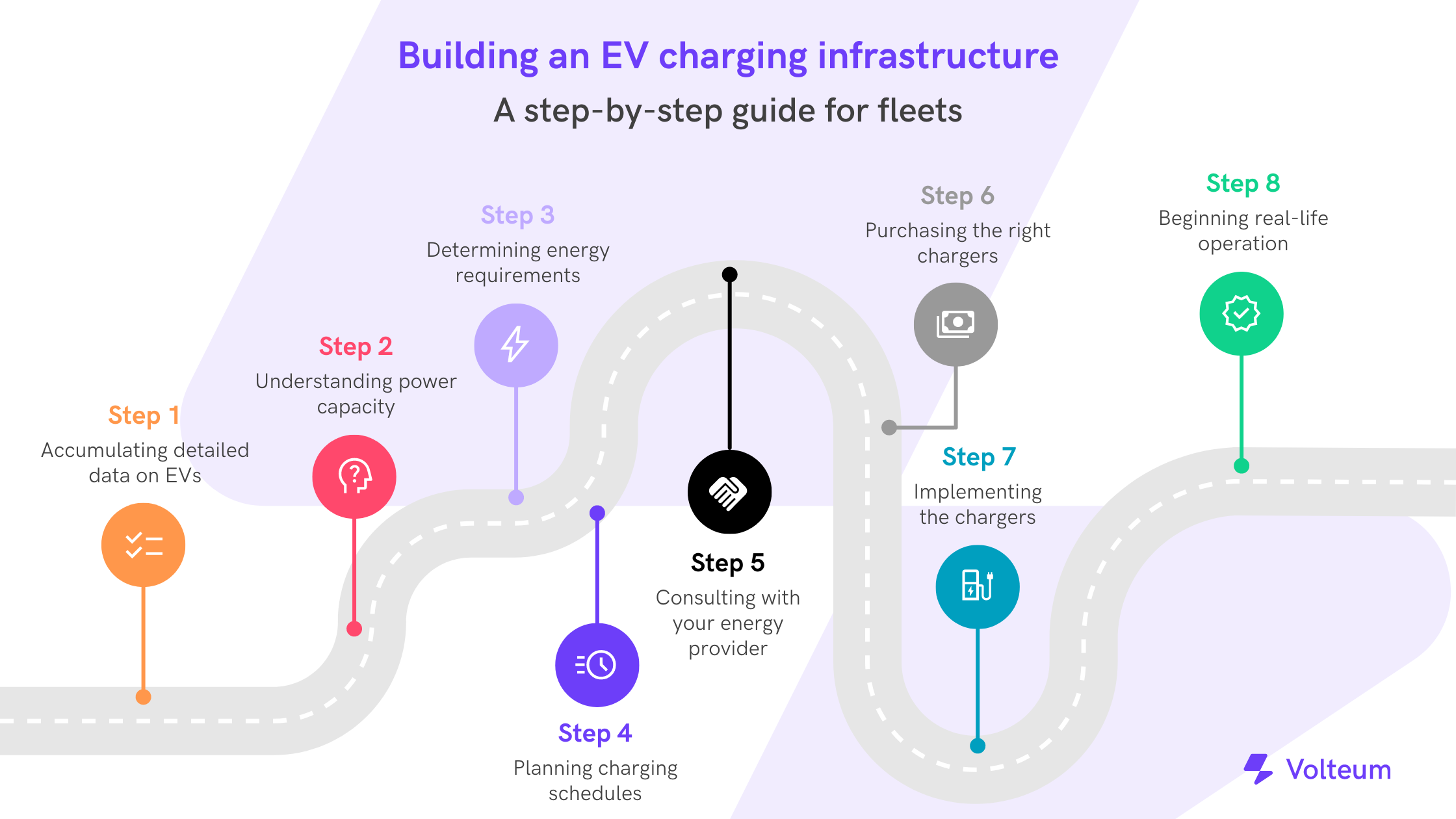Building an EV charging infrastructure: A step-by-step guide for fleets
Jul 27, 2023 · 5 min read · blog
Switching your company fleet to electric vehicles is more than just buying the vehicles. It also involves thoughtful planning and careful organization of an effective EV charging infrastructure. Proper planning can ensure maximum grid capacity, effective cost control, compatibility with the EVs, and maintenance of the operational efficiency of your fleet. Let's examine the steps required to build a solid charging infrastructure for your EV fleet.

Step 1 - Breaking ground: Accumulating detailed data on EVs

The first step in creating an effective infrastructure plan is to gather detailed data on the EVs that your fleet will consist of. This involves collecting comprehensive information on each EV, such as the type of EV, battery capacity, charging speed, and the type of charger it requires. It's also important to understand the daily, weekly, and monthly usage patterns of each EV, including the distance travelled, typical routes, and operating hours. Gathering this information can help you understand each vehicle's individual charging needs, setting the stage for successful infrastructure planning.

Step 2 - Liaising with your grid operator: Understanding power capacity

The next crucial step is to contact your local grid operator to understand the maximum power capacity at your site. This will also help you understand the costs associated with expanding this capacity if necessary. By understanding your site's power limitations and potential for expansion, you can better plan for your charging infrastructure.

Step 3 - Processing data: Determining energy requirements

After collecting all necessary data, the next step is to analyze the data to determine how much energy each vehicle will need daily, weekly, and monthly. This involves evaluating each EV's usage patterns and considering factors like battery efficiency, average journey lengths, idle times, and seasonal changes in energy consumption. The use of advanced software like Volteum's Electric Fleet Planner can turn this complex task into a simple one, giving you precise, automated analysis and saving you time and resources.

Step 4 - Combining information: Planning charging schedules

With the energy requirements of each vehicle calculated, you can now consolidate the data and create a strategic charging schedule. This involves bringing together all the information you have gathered so far and creating a schedule that optimizes energy use, minimizes costs, and maintains fleet efficiency. The use of Volteum's Electric Fleet Planner can make this process much simpler, helping you create effective schedules quickly and accurately.

Step 5 - Seeking professional guidance: Consulting with your energy provider

After creating a detailed list of required chargers and their necessary specifications, it's important to consult with a professional. This can be your energy provider or an independent expert who can review your plans and help you understand whether your grid capacity will need expansion, how to maximize energy efficiency, and how to avoid common pitfalls during implementation. This step can reassure you that your plan is viable and can help prevent costly mistakes.

Step 6 - Investing in chargers: Purchasing the right ones

Having gone through the planning and consultation phases, you are now ready to purchase the chargers. This process can be complex, depending on the size and diversity of your fleet, and involves considering several factors such as the type of charger, compatibility with your vehicles, required charging speed, installation requirements, cost, and warranty terms.

Step 7 - Putting plans into action: Implementing the chargers

After purchasing the chargers, you're ready for their installation and integration into your daily operations. This phase involves careful attention to charger placement, accessibility, safety, and integration with your current electrical system. It's important to provide training to all staff members who will use the charging system to ensure safety and effective usage.



Step 8 - Stepping into reality: Beginning real-life operation

Starting real-life operation of your charging infrastructure is a major step, and one we will cover in a separate blog post.

Creating an EV charging infrastructure may seem like a daunting task, but with careful planning and the use of helpful tools like Volteum's Electric Fleet Planner, it can be a much smoother process. As you begin your journey towards an electric fleet, keep in mind that sustainability, efficiency, and strategic planning are key to success. Keep an eye out for our next blog post where we will discuss the real-life operation of your charging infrastructure. Welcome to the electric future!